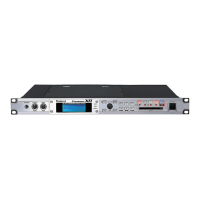73
Creating a Rhythm Set
Cautions When Using a Loop
Waveform
With many acoustic instruments such as piano and sax, extreme
timbral changes occur during the first few moments of each note.
This initial attack is what defines much of the instrument’s character.
For such waveforms, it is best to use the complex tonal changes of
the attack portion of the waveform just as they are, and to use the
envelope only to modify the decay portion. If you attempt to use the
envelope to modify the attack portion as well, the characteristics of
the original waveform may prevent you from getting the sound that
you intend.
fig.06-006.e
This section explains the functions the different rhythm set
parameters have, as well as the composition of these parameters.
For details on these settings, refer to
“How to Make Rhythm
Set Settings”
(p. 71).
Rhythm Level applies to the entire rhythm set; the other
parameters are set individually for each rhythm tone.
Rhythm General
Rhythm Level (Rhythm Set Level)
Sets the volume of the rhythm set.
Value:
0–127
The volume levels of the tones from which the rhythm set is
composed is set with the Tone Level parameter (p. 80). The
volume levels of the Waves from which the rhythm tone is
composed is set with the Wave Level parameter (p. 76).
Rhythm Tone Name
You can assign a name of up to 12 characters to the rhythm tone.
Use [ ][ ] to move the cursor, and use the VALUE dial to select a
character.
Value:
space, A-Z, a-z, 0-9, ! " # $ % & ’ ( ) * + , - . / : ; < = > ? @ [
\ ] ^ _ ` { | }
For details on assigning names, refer to
“Assigning a Name”
(p. 39)
Assign Type
Assign Type sets the way sounds are played when the same key is
pressed a number of times.
Value
MULTI:
Layer the sound of the same keys. Even with continuous
sounds where the sound plays for an extended time,
such as with crash cymbals, the sounds are layered,
without previously played sounds being eliminated.
SINGLE:
Only one sound can be played at a time when the
same key is pressed. With continuous sounds where
the sound plays for an extended time, the previous
sound is stopped when the following sound is played.
Tone change stored
with the wave
Envelope
for the TVF filter
Resulting
tone change
Looped portion
Time
Level
Functions of Rhythm Set
Parameters
Making Settings Common to the
Entire Rhythm Set (GENERAL)
Fantom-XR_r_e.book 73 ページ 2006年4月4日 火曜日 午前10時14分

